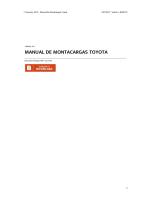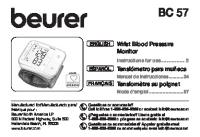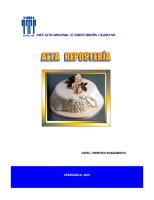E&L fx5030 Manual
Description B Ultrasound edge sensor FX 5030, FX 5060, FX 5100 1. Safety 2. Type overview 3. Function 4. Assembly 5. I
Views 33 Downloads 0 File size 111KB
Recommend stories
- Author / Uploaded
- Deming
Citation preview
Description B
Ultrasound edge sensor FX 5030, FX 5060, FX 5100
1. Safety 2. Type overview 3. Function 4. Assembly 5. Installation 6. Commissioning 7. Operation 8. Settings and error messages 9. Maintenance 10. Connection diagram 11. Technical data
e
2 2 2 4 5 5 6 7 8 8 9
BEA--218004-E-03
Ultrasound edge sensor FX 5030, FX 5060, FX 5100
1. Safety 1.1 Explanation of symbols 1.2 Intended usage
➜ jobs to be performed important information and instructions The E+L ultrasound sensor is constructed according to state-of-theart technology and is used for contact-free web edge scanning. The ultrasound edge sensor should only be used - in perfect technical condition, - for use as intended, - in accordance with the operating instructions.
1.3 Operating manual
Please keep the above in a safe place and make accessible to personnel at all times. The manual is part of the package supplied and should be read carefully prior to assembly, operation and maintenance.
1.4 Safety instructions
Never touch the edges of running webs. Never open the transmitter or receiver housing when the edge sensor is switched on. High voltage!
2. Type overview
Types FX 5030 and FX 5100 differ only in the distance between the transmitter and receiver (usable area). Type FX 5030 FX 5060 FX 5100
Usable area < 30 mm < 60 mm < 124 mm
3. Function 3.1 Purpose
The ultrasound sensor scans the web edges of sound absorbing materials such as paper, film or tightly knitted fabrics without touching. It is especially suitable for light-sensitive transparent materials where optical edge sensors can only be used to a limited extent.
3.2 Design
The edge sensor consists of: - a transmitter with four transmitting elements - a receiver with four receiving elements - a connecting section
B page 2
Ultrasound edge sensor FX 5030, FX 5060, FX 5100
Receiver
Usable area
Connecting section
Transmitter
3.3 Operating principle
The edge sensor works on a sound-voltage conversion principle. The transmitter elements produce ultra-sound pulses which are transmitted in the air to the receiver elements opposite. Depending on how much of the transmitter element is covered by the web, more or less sound energy will reach the receiver element opposite. This energy is converted into a signal voltage and then a digital value. The microcontroller determines which pair of elements is currently active depending on the web position. The signals from the individual receiver elements are converted into a output value proportional to the web edge position and transmitted to the CAN bus. This output value can be used e.g. to activate a digital controller. At the same time, the actual web edge position in the measuring range is displayed on a row of LEDs. If the LED beside the row of LEDs lights up green, the edge sensor is signalling that it is ready for operation. If it lights up red, it is indicating a fault.
B page 3
Ultrasound edge sensor FX 5030, FX 5060, FX 5100 3.4 Edge sensor measuring range
The edge sensor measuring range is ±10 mm and is resolved in 1229 units. In this range, the edge sensor provides a position value corresponding to the location of the web edge.
Measuring range ±10 mm
The zero position is usually in the center of the measuring range. It can be offset in conjunction with a digital controller.
Web Zero position
4. Assembly
Two M 5 threads each are featured on the transmitter and receiver housing for assembly purposes. ➜ Mount the edge sensor so that the web runs at a angle of 90° to it.
Threads M5
The level of the web between the transmitter and receiver in relation to the center may fluctuate by the following: FX 5030 < ±15 mm FX 5060 < ±30 mm FX 5100 < ±62 mm The accuracy of the edge sensor cannot be guaranteed outwith these ranges. During operation, the web must not touch either the transmitter or the receiver. Air turbulence due to temperature fluctuations in the edge sensor scanning area may impair the measuring result and for this reason must be avoided.
B page 4
Ultrasound edge sensor FX 5030, FX 5060, FX 5100
5. Installation
➜ Protect signal leads and run apart from heavy current-carrying leads. ➜ Tighten the union nuts. These ensure that the edge sensor housing and the signal lead insulation are conductively connected. ➜ Secure the signal lead with a cable clamp. Subject to heavy static charging of the web, we recommend connecting the edge sensor housing to the machine frame.
6. Commissioning
On compact units, no adjustment to the edge sensor is needed on first-time commissioning. If you have ordered control elements separately and wish to link them up yourself in a functioning control loop or if the edge sensor is supplied not ready installed, you must check/set the group and unit numbers on the edge sensor. The group number depends on the digital controller (identical to the group number of the web guider to which it belongs). Edge sensor on right in web direction of travel, unit number "1" Edge sensor on left in web direction of travel, unit number "2" Direction of web travel = Processing direction for the entire system ➜ Set the controller to "center position" mode.
Edge sensor to left of web direction of travel
Device number 2 Group number 0
➜ Press the "GRP" and "DEV" buttons on the edge sensor at the same time. After about 6 seconds the group and unit numbers on the LED display will start to flash. After approx. a further 20 seconds the edge sensor switches into setup mode. The LEDs stop flashing and stay on permanently and the group number (GRP button) and unit number (DEV) can be changed. If the "GRP" and "DEV" buttons are not pressed for longer than 1 minute, the group and unit numbers are stored and setup mode exited.
Processing direction for the entire system
Group number 0 Device number 1
Edge sensor to right of web direction of travel Example: setting the group and device numbers
B page 5
Ultrasound edge sensor FX 5030, FX 5060, FX 5100
7. Operation
With the help of the row of LEDs on the receiver, the edge sensor can be manually positioned at the web edge.
7.1 Positioning the edge sensor
➜ Set the web offset on the digital controller to "0". ➜ Position the edge sensor manually: - If the web is at its set position, place the edge sensor at the web so that only the two middle LEDs, 7 and 1 are on (display mode 0). In display mode 1, LEDs 0 to 7 are illuminated, see fig. below.
Display mode 0 (Standard) LEDs 7 and 1 are on
Display mode 1 LEDs 0 and 7 are on
Web edge set position
Web edge set position
- If the web is not at its set position or no web is available, position the edge sensor so that the center of the scanning range coincides with the web edge set position.
B page 6
Ultrasound edge sensor FX 5030, FX 5060, FX 5100
8. Settings and error messages
In setup mode, setup parameters may be displayed and, to a certain extent, changed. To enter edge sensor setup mode, a command station DO ...., a digital controller DC 55.. or operator panel RT .... are required. The parameter numbers are listed in the Number field of the table, the short form of the error in the Name field. The Default field indicates the standard settings, Min and Max are the permissible limit values in each case. The Access field shows whether a parameter may only be read (R) or read and written (R/W). The Description field explains the parameter function.
Number
Name
Default
Min
Max
Access
..0.
edit device
X.X
X.1
X.F
R/W
Device number (see block diagram)
..1.
edit group
X.X
0.X
7.X
R/W
Group number (see block diagram)
..2.
reset settings
0
0
2
R/W
Works setting 0 = no funktion 1 = E+L basic settings 2 = internal value specification (default)
..3.
start service
0
0
199
R/W
Starting a function 0 = no function 1 = reset 2 = save parameter 100 = perform sensor calibration
..4.
ultrasonic sensor
-
-
-
R
..5.
inversion
0
0
1
R/W
..6.
resolution abs.
1229
..7.
range +/-
..8.
position
0
..9.
error code
0
0
.1.0.
display OFF
0
.1.1.
display mode
.1.2.
1229 1229
Description
Software version Reverse sensor signal
R
available sensor measuring range in pixels
R
available sensor measuring range in mm
R
position of guiding criterion in relation to sensor zero pointpunkt in 1/100 mm
6
R
General error messages: 0 = no error 1 = error in EEPROM 2 = operating temperature exceeded/not reached (temperature < 0 °C or > 60 °C) 3 = Wrong transmitter calibration data in EEPROM 4 = Wrong receiver calibration data in EEPROM 5 = Receiver error during calibration 6 = Error in receiver element
0
1
R/W
ON/OFF display 0 = display ON (Standard) 1 = display OFF
0
0
1
R/W
Display mode 0 = normal display (LED 7+1 light up) 1 = web edge is displayed as illuminated strip
temperature
0
-60
150
R
.1.3.
fork width
42
25
175
R/W
.1.4.
calibration point
0
0
22
R
-10
10
-1000 1000
Interior temperature of edge sensors in °C Fork width in mm internal basic settings
B page 7
Ultrasound edge sensor FX 5030, FX 5060, FX 5100
9. Maintenance
Maintenance work should only be performed when the processing machine is switched off. ➜ Depending on the ambient conditions, the transmitter and receiver elements may have to be blow cleaned. The air pressure must not exceed 6 bar. The four transmitter and receiver elements are sealed in a flexible plastic support and must not be exposed to any mechanical pressure (e.g. finger touch).
10. Connection diagram
Power supply
Transmitter
YE BN GY PK WH GN
= yellow = brown = grey = pink = white = green
Receiver
Amplifier Controller
The length of the individual cables must be deducted from the maximum cable length in a CAN network. For one edge sensor it may be a maximum of 8 m, for two sensors a maximum of 16 m.
B page 8
Ultrasound edge sensor FX 5030, FX 5060, FX 5100
11. Technical data
Supply voltage Nominal value permissible range (including ripple) Current input Current input Transmission frequency Modulation frequency Measuring range Deviation in linearity (Measuring range 10 - 90%) Measuring precision Ambient temperature Storage temperature Temperature drift (typical) with a relative humidity of 60 % Scanning rate Line length Protection class Max. installation height Weight Dimensions
24 V DC 20 - 30 V DC approx. 170 mA display ON approx. 100 mA display OFF 200 kHz moduliert 1 kHz ±10 mm









